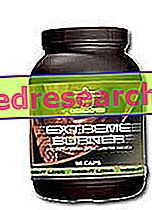By Dr. Rita Fabbri
The pharmacological activity of the Pineapple is linked to the Bromelain contained above all in the stem; to this substance proteolytic, anti-inflammatory properties of soft tissues, analgesic, antiedematous and fibrinolytic are attributed; Bromelain also has mucolytic, immunomodulatory and gastroprotective activity; besides it seems able to relax the smooth muscles; it is capable of draining liquids and for this reason it is inserted in over-the-counter slimming products.
For topical use it is used in the treatment of ulcers and burns.
In supplements formulated for dyspepsia, bromelain is often associated with other proteolytic enzymes (such as trypsin and papain).
Thanks to its proteolytic activity, Bromelain is also used in the food industry in order to soften canned meat.
Pineapple contains organic acids (citric acid, malic acid and oxalic acid) which give the fruit a diuretic action.
Bromelain comprises a group of proteolytic enzymes (or proteinases) sulfidrici. The Bromelin contained in the stem of the Pineapple is a mixture of at least 8 proteinases and small amounts of non-proteolytic enzymes (3). In the stem, there are also two cysteine proteinases, the comosain and the ananaine, enzymatically related to bromelain (4).
Bromelain is unstable to heat, so its pharmacological activity can be reduced by inappropriate treatments or poor storage.
Being sulfhydric proteinases (such as papain and ficin), the bromeline extracted from the pineapple stem or from the fruit are inactivated by oxidizing agents (such as hydrogen peroxide or methyl bromide) and by certain metal ions (for example lead, copper and iron) . Human serum also inhibits the digestive activity of Bromelain; Magnesium and cysteine are instead activators of bromelain on the market (5).
As an enzyme, the concentration of bromelain is expressed in enzymatic units, which indicate the ability of the enzyme to digest a certain amount of protein.
The Food Chemistry Codex (FCC) officially recognizes mcu (milk clotting units) as enzymatic units . Even the gdu (gelatin digesting units) are accepted and are equivalent to mcus.
By varying the mcus, the activity of Bromelain varies; therefore it is not easy to establish a priori what the effective dosage can be. Normally, Bromelain has an activity of between 1200 and 1800 mcu and the typical dosages range between 250-500 mg three times a day between meals (6-7).
Very high doses of Bromelain (around 2 g) were administered without side effects (DL 50> 10g / Kg of body weight); also the use for a long time seems to be well tolerated (8).
Bromelain can be administered orally, parenterally or by intravenous infusion and it has been established that up to 40% of bromelain administered orally can be absorbed as such (9-11).
Bromelain has been known chemically since 1876, but only in 1957 was it introduced as a therapeutic substance; since then numerous scientific studies have been published on its therapeutic applications. The following are the most significant.
| Digestive activity | Anti-inflammatory and anti-edematous activity |
| Arthritis | Surgical interventions |
Digestive activity
Bromelain is very effective in the dyspepsia for gastric and pancreatic enzyme deficiency, in fact it can be considered an excellent substitute for trypsin or pepsin (12-13). Bromelain is active both in the acid environment - therefore at the gastric level - and in the neutral environment, therefore in the enteric district.
- In a double-blind study, the administration of bromelain together with pancreatin and bovine bile was effective in the treatment of patients with pancreatic insufficiency (14).
Because of its digestive activity, pineapple can be taken even after large meals; Bromelain in fact manages to mitigate the symptoms of gastric disorders or burning, particularly if used in combination with other enzymes such as amylases and lipases.
Anti-inflammatory and anti-edematous activity
Bromelain is indicated in all cases of inflammation and / or edema of soft tissues.
The anti-inflammatory effect may be due to the proteolytic activity of Bromelain on the site
inflammation; hypothesis to be confirmed also because the proteolytic action is inhibited by factors present in the serum. Much more probably, Bromelain, due to interaction with lipoxygenase, determines an increase in the formation of plasmin, which has fibrinolytic activity, ie it is capable of breaking down fibrin, preventing or reducing the formation of localized edema; plasmin also reduces the synthesis of pro-inflammatory prostaglandins and stimulates the formation of prostaglandin E1, an inhibiting factor of inflammation (15-18).
It has also been shown that Bromelain reduces quininogen plasma levels, thus inhibiting the formation of quinines (19-20): quinines generate vasoactive peptides, thus causing inflammation, edema and pain.
All these factors contribute to an improvement of the circulation, in the cellular metabolism, in the cutaneous tropism and in the reabsorption of edema, exudates, hematomas, necrotic substances and inflammatory agents.
The anti-inflammatory activity of Bromelain is certainly the most significant, also because it intervenes on many aspects of inflammation (21, 41); it is confirmed in several experimental models (such as albumin or carrageen induced edema) and finds in humans several clinical applications. Below are the most important ones.
Arthritis
Bromelain can be useful both in rheumatoid arthritis and in osteoarthritis. In particular in rheumatoid arthritis it allowed the reduction of the use of corticosteroids (such as prednisone).
- In one study, Bromelain was administered to some patients: 25 with severe rheumatoid arthritis, 1 with rheumatoid arthritis and osteoarthritis, 2 with osteoarthritis, 1 with gout and joint edema. Corticosteroid doses have been reduced to minimum maintenance doses with simultaneous administration of gastro-resistant bromelain (20-40 mg three or four times a day). In most patients a significant reduction in joint edema and an increase in joint motility were noted, shortly after the start of treatment. In the observation period from 3 weeks to 13 months, 8 of 29 patients (28%) found excellent effects, 13 (45%) good, 4 (14%) discrete and 4 (14%) poor, as in the case of the patient with gout (22).
In a clinical study, the effect of bromelain was evaluated in patients with knee osteoarthritis with the result that it was not effective (23). Perhaps better results could have been obtained by giving Bromelain in a non-gastro-resistant form.
Surgical interventions
Bromelain administered orally has given positive results in the reduction of edema, ecchymoses, healing time and post-operative pain (24). In particular, in case of interventions at the oral cavity, a treatment with Bromelain is recommended before and after the operation.
- In a double-blind study of patients undergoing oral surgery, it was found that the effect of bromelain is significantly higher than that of placebo. The edema was reduced in 3/4 days with bromelain compared to 7 days with placebo; the duration of pain was 5 days in the bromelain group, compared to 8 days in the placebo group (25).
Similar observations have been confirmed in studies of episiotomy cases (surgical incision of the perineum, lateral to the vagina, during childbirth): Bromelain reduces edema, inflammation, pain and administration before surgery enhances the effects (26-27).
In a double-blind study, Bromelain favored the reduction of edema and ecchymoses in patients undergoing rhinoplasty surgery (28).



